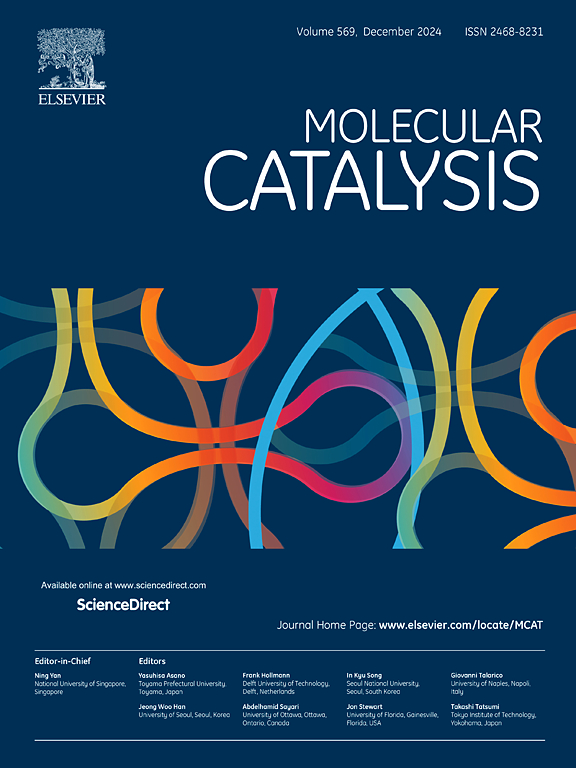共掺杂Pt-LaMnO3催化剂的a位增强了NO的氧化活性
IF 3.9
2区 化学
Q2 CHEMISTRY, PHYSICAL
引用次数: 0
摘要
钙钛矿氧化物通常用于柴油尾气后处理系统中NO氧化生成NO2的反应。元素取代通常用于修饰钙钛矿以提高其氧化还原性能。以不同含量的Co取代LaMnO3中的La,制备了一系列的Pt-La1−xCoxMnO3。Pt-La0.8Co0.2MnO3在新鲜状态(NO转化率为52.7%)和老化状态(NO转化率为44.7%)均表现出优异的NO氧化活性。XRD和TEM结果证实,部分Co掺杂到晶格中取代La,其余Co以CoMn2O4相的形式存在。XPS、Raman和EPR结果表明,Co-O-Mn结构在LaMnO3和CoMn2O4界面发生电子转换,导致Mn3+增多,Mn-O键减弱,氧空位增加,有利于O2活化。此外,NO- tpd和原位漂移证实,随着Mn4+的减少,Co3+也作为NO的吸附和活化位点。O2和Co3+的氧空位增加对NO的吸附和活化作用增强了NO的氧化活性。本文章由计算机程序翻译,如有差异,请以英文原文为准。
A-site of Co-doped Pt-LaMnO3 catalyst enhances NO oxidation activity
Perovskite oxides are always applied in the reaction of NO oxidation to NO2 for diesel exhaust after-treatment systems. Elemental substitution is commonly used to modify the perovskites to enhance their redox properties. In this work, a series of Pt-La1−xCoxMnO3 was prepared with different contents of Co replacing La in LaMnO3. Pt-La0.8Co0.2MnO3 exhibited outstanding NO oxidation activity at the fresh state (NO Conversion = 52.7 %) and at the aged state (NO Conversion = 44.7 %). XRD and TEM results verified partial Co doping into the lattice to replace La, while the other Co existed in the form of CoMn2O4 phases. XPS, Raman, and EPR results showed that electron transformation occurring on the Co-O-Mn structure from the interface between LaMnO3 and CoMn2O4 led to more Mn3+, the Mn-O bonds were weakened, and oxygen vacancies increased to facilitate O2 activation. Besides, NO-TPD and in situ DRIFTS confirmed that Co3+ also served as NO adsorption and activation sites with the decline of Mn4+. The cooperative effort of increasing oxygen vacancies for O2 and Co3+ for NO adsorption and activation enhances the NO oxidation activity.
求助全文
通过发布文献求助,成功后即可免费获取论文全文。
去求助
来源期刊

Molecular Catalysis
Chemical Engineering-Process Chemistry and Technology
CiteScore
6.90
自引率
10.90%
发文量
700
审稿时长
40 days
期刊介绍:
Molecular Catalysis publishes full papers that are original, rigorous, and scholarly contributions examining the molecular and atomic aspects of catalytic activation and reaction mechanisms. The fields covered are:
Heterogeneous catalysis including immobilized molecular catalysts
Homogeneous catalysis including organocatalysis, organometallic catalysis and biocatalysis
Photo- and electrochemistry
Theoretical aspects of catalysis analyzed by computational methods
 求助内容:
求助内容: 应助结果提醒方式:
应助结果提醒方式:


